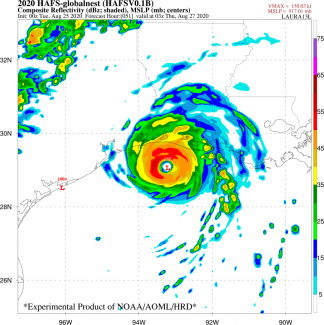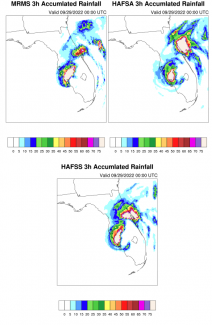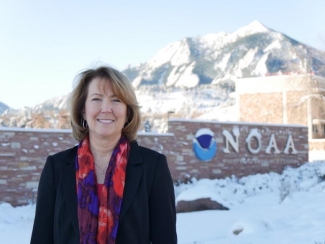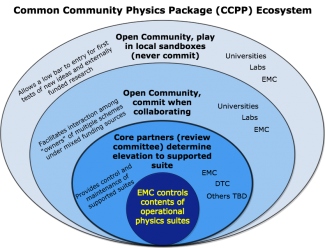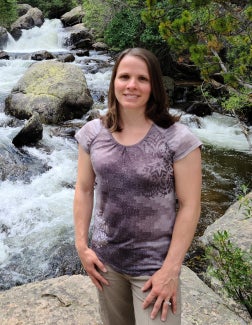The Hurricane Analysis and Prediction System (HAFS) v1 has been approved for operational implementation for the 2023 hurricane season by NOAA NCEP and, with it, the Common Community Physics Package (CCPP) will be deployed operationally for the first time. This is a major milestone for this software infrastructure. The first set of requirements for the CCPP was established in 2017, following numerous discussions by the Physics Interoperability Team, which was assembled under the auspices of the Earth System Prediction Capability (ESPC, now Interagency Council for Advancing Meteorological Services [ICAMS]).
Lead Story
CCPP Goes Operational
Over the last six years, the CCPP was established with two major components: the CCPP Physics, a library of physical parameterizations, and the CCPP Framework, the infrastructure that connects the library to host models. The Framework has undergone extensive development to meet the needs of the research and operational communities. One example is the static build, in which a number of suites can be provided at compile time, resulting in the auto-generation of suite-specific physics interfaces to the model (called caps), to be included inside of the model executable. This approach gives the flexibility required by the research and development community (by providing the ability to choose a menu of suites at runtime), while being efficient in computational memory use and timing.
The benefits of the CCPP go beyond those provided by the Framework. The CCPP Physics contains a number of physical parameterizations that can be assembled into suites. This approach enabled the UFS Hurricane Application team to experiment with different designs for HAFS, finally settling on two configurations to satisfy the needs of the National Hurricane Center (NHC). The physics suites for these two HAFS implementations apply different physics suite configurations: HAFS-A uses the GFDL single-moment microphysics and HAFS-B uses the Thompson double-moment microphysics. The configurations also differ in customizations to the convective and planetary boundary layer (PBL) schemes and in the frequency of calls to the radiation parameterization.
The DTC Visitor Program also played an important role in supporting the community engagement with the development of physics for HAFS. Dr. Andrew Hazelton, from the University of Miami Cooperative Institute of Marine and Atmospheric Science (CIMAS) and affiliated with NOAA’s Atlantic & Oceanographic Meteorological Laboratory, was the recipient of a DTC award for the improvement of PBL representation for better forecasts of tropical cyclone structure and large-scale steering (see Winter 2023 DTC Newsletter).
The DTC is responsible for the code management of the CCPP repositories, and co-manages the UFS fork of CCPP Physics in Github. This fork, which is used by those contributing physics intended for the UFS, is directly connected to the UFS Weather Model and used in all UFS Applications. The DTC reviews git repository pull requests for bug fixes and innovations, and connects with experts to obtain additional input. The DTC also represents the CCPP component on the UFS Weather Model code management team, ensuring that changes in CCPP are well coordinated with the rest of the model. Physics contributions from the community, such as those from Dr. Hazelton, are critical to improving the UFS skill. Given the distributed nature of the UFS development, with contributions from the NOAA Weather Service and Research Laboratories, as well as NCAR and academia, a robust code management strategy is critical to foster collaborations while maintaining agility.
In summary, the CCPP has come a long way since its inception, laid a strong foundation for research and development (R&D) and transitions, and achieved readiness to support operational implementations of the UFS Weather Model and its applications. We are looking forward to seeing HAFS v1 go live and contributing to the suite of models used by the NHC to create its forecasts.
For more news related to CCPP, see the Community Connections article: A Forward-looking Virtual Get-together of the CCPP Community.
Director's Corner
Jennifer Mahoney
The DTC serves a vital role in advancing NOAA’s modeling efforts and the community-based Unified Forecasting System (UFS). The DTC is research to operations (R20) and operations to research (O2R) in action. Through model evaluations and support to the community, the impact of the DTC in the delivery of new models and techniques to operations and the community has been profound. I would like to highlight a few achievements here.
First, the partnerships cultivated through the DTC are far reaching and have been highly successful in connecting the weather community with the operational prediction community. The DTC Visitor Program is an excellent example of this successful collaboration.
Secondly, the DTC is fostering significant scientific improvements in NOAA’s operational models. For instance, the DTC contributed foundational infrastructure to the Short-Range Weather (SRW) Application, which is providing the foundation for the Rapid Refresh Forecast System (RRFS), NOAA’s newest community-base model soon headed for operational implementation in 2024. In order to engage the weather community in the development of the RRFS, the DTC spearheaded the development of code management protocols and a user workflow, which were adopted by the Earth Prediction Innovation Center (EPIC) and provided to the research community. These technologies are being used to accelerate RRFS development toward the finish line.
In another example, the DTC was instrumental in preparing the Hurricane Analysis and Forecast System (HAFS) for operational implementation, which is scheduled for operations in the 2023 hurricane season. Using process-based diagnostics to explore model performance, the DTC staff provided information that improved the representation of physical processes in HAFS and provided insight for advancing forecast skill. The figure below highlights one of the comparisons performed in the study.
The DTC is facilitating improvements in FAA operational weather products. In one example, the DTC staff evaluated the use of the hybrid sigma-pressure coordinate in the Rapid Refresh (RAP) and the High-Resolution Rapid Refresh (HRRR) operational models. Based on their analyses, spurious noise in complex terrain within the models was reduced resulting in a more coherent mountain wave feature. By improving these mountain wave features, improvements in turbulence forecasts produced by NWS serving aviation operational decisions were realized (Beck et. al, 2020: An Evaluation of Hybrid, Terrain-Following Vertical Coordinate in the WRF-based RAP and HRRR models).
Tools and technologies are also developed by the DTC staff. For instance, the popular Common Community Physics Package (CCPP) was designed and developed to facilitate the implementation and transition of physics innovations into NOAA’s atmospheric operational models. Moreover, the tool has become a core component to all UFS applications and has been released to the community for advancing numerical model research; it is on track for transition to NWS as part of the HAFS system; and the CCPP is undergoing pre-operational testing at the Naval Research Laboratory.
The future of the DTC is bright. With the renewed emphasis on testing and evaluation of model improvements, innovations into NOAA’s models are sure to accelerate.
Acknowledgement: I would like to thank Jeff Beck, Linlin Pan, Man Zhang, and Ligia Bernardet for their helpful input.
Who's Who
Xia Sun
Xia Sun is a numerical weather prediction (NWP) scientist working at the Cooperative Institute for Research in Environmental Sciences at the University of Colorado Boulder (CIRES) and NOAA Global Systems Laboratory. Xia works on hierarchical system development for the Unified Forecast System (UFS) and MYNN-EDMF planetary boundary layer (PBL) physics scheme. Before that, Xia lived in Reno, Nevada for three and half years to finish her Ph.D program in Atmospheric Sciences at University of Nevada, Reno. Xia has a research background in land-atmospheric interactions, chemical transport modeling, and boundary layer meteorology.
Xia spent her early childhood in a town in North China Plain. Once she was ready to attend middle school, she attended boarding school where she flourished and cultivated independence at a young age. She began keeping detailed journals to document her boarding school experiences, which she shared with her family as a way of painting a picture of her life that would later become an archive of her cherished memories from her earlier life.
Xia always wanted to work in the meteorology field, even when she was little. Her interest began when she would visit her aunt’s workstation at a weather modification office in a local meteorological bureau when she was only about six years old. She was particularly fascinated by the potential impacts that weather modification (through cloud seeding) might have on our lives. Motivated by these interests, she pursued a major in Atmospheric Physics in college.
Xia’s typical work day at her NOAA job involves code development and data visualization and analysis. She enjoys collaborating with her colleagues, exchanging ideas, and brainstorming together. Xia is currently working on projects focused on improving simulated marine boundary-layer cloud morphology and wind-forecast improvement along the east coast. The project Xia is working on at DTC and serves as a co-lead is applying a hierarchical approach, from simple to complex systems, to improve the deterministic and stochastic parameterizations. She uses a single-column model driven by a forcing dataset post-processed from high-resolution model simulations to investigate model uncertainty and inform stochastic parameterizations development.
The most fulfilling part of Xia’s job is knowing the positive impacts NWP scientists have on society. More accurate weather forecasts contribute to public safety and the well-being of people. The work of NWP scientists involves collaborating to advance our understanding of the complex behaviors of the atmosphere to refine and improve the model, drawing knowledge from disciplines such as physics, mathematics, and chemistry, among others. The collaborative environment makes the job dynamic and engaging. The intellectual stimulation through the community collaboration is another rewarding aspect of her work.
In her spare time, Xia likes to hike in the Colorado mountains with her family, weather permitting, of course. Hiking reminds her of the importance of perseverance, respect for nature, and the reward of beautiful views that cannot be seen elsewhere. Xia also loves visiting theme parks and national parks with her family and friends. Theme park visits make beautiful memories for the whole family, especially for Xia’s daughter, Mira. National parks offer an adventure that allows one to connect with the natural world and enjoy the breathtaking views of mother nature.
Xia’s favorite quote is “Go as far as you can see; when you get there, you'll be able to see further”--by Thomas Carlyle. This quote encourages her to step out of her comfort zone. By continuously pushing ourselves and embracing new experiences, we will envision new opportunities that were previously beyond our horizon.
Bridges to Operations
Initial Operational Implementation of the UFS Hurricane Application
The initial operational implementation of the Hurricane Analysis and Forecast System (HAFS) for tropical cyclone (TC) forecasting was recently approved for operations by the NOAA National Centers for Environmental Prediction (NCEP) Central Operations (NCO) in advance of the 2023 Atlantic basin hurricane season. HAFS is the operational instantiation of the Unified Forecast System (UFS) hurricane application, with a focus on transitioning TC modeling research to operations. HAFS is an atmosphere-ocean-wave coupled TC forecast system, featuring convection-allowing high-resolution storm-following nests, vortex initialization, inner-core data assimilation, and TC-calibrated model physics.
The development of HAFS began in 2019, when increasingly complex configurations of HAFS (HAFSv0.0 through HAFSv0.3) were run and evaluated during the Hurricane Forecast Improvement Project (HFIP) real-time demonstration (see figure below), providing the groundwork for HAFSv1.0.
For the initial operational capability of HAFS (HAFSv1.0), two distinct configurations were selected to replace the existing regional operational hurricane forecast systems, Hurricane Weather Research and Forecast (HWRF) and Hurricanes in a Multi-scale Ocean-coupled Non-hydrostatic Model (HMON). The HAFSv1.0a (HFSA) configuration will replace HWRF; whereas the HAFSv1.0b (HFSB) configuration will replace HMON. Both HAFS configurations include a storm-centric domain with one moving nest at 6 km and 2 km, respectively, 81 vertical levels, and a 2-hPa model top. Additionally, both configurations employ four-dimensional ensemble variational (4DEnVar) data assimilation with warm-cycling vortex initialization (VI) and two-way HYbrid Coordinate Ocean Model (HYCOM) ocean coupling.
For HFSA, unique features include a slightly larger parent domain than HFSB, one-way wave (WAVEWATCH III, WW3) coupling, a greater maximum wind threshold for VI, and up to seven storms run for all global basins. The HFSB configuration does not include wave coupling, and runs up to five storms for National Hurricane Center (NHC) and Central Pacific Hurricane Center (CPHC) basins only. In order to provide additional diversity, HFSA and HFSB apply two different physics suites. The major differences between the HFSA and HFSB physics suites stem from the planetary boundary layer (PBL) and microphysics schemes, with the HFSB configuration employing an enhanced TC PBL option (Chen et al. 2022) and the Thompson double-moment microphysics scheme, as opposed to the GFDL single-moment microphysics for the HFSA configuration. Both HAFS configurations demonstrated improved track and intensity skill relative to the current operational hurricane models over a 3-year retrospective period covering all storms in the Atlantic and Eastern Pacific basins, leading to the operational implementation of HAFS as part of NOAA NCO.
Throughout this process, the DTC provided software management and community support to ensure that distributed development efforts for HAFS were achievable through strong code governance and a developer support system. In addition to their community engagement role, DTC also conducts independent testing and evaluation (T&E), which focuses on providing value-added evaluations for HAFS forecasts during the pre-implementation process. For HAFSv1.0, the DTC used the enhanced Model Evaluation Tools (METplus) to provide TC-centric evaluations such as track, intensity, rapid intensification, large-scale, and quantitative precipitation forecast (QPF) verification. These evaluations provided additional evidence and support for the HAFSv1.0 implementation into operations. For example, the evaluation provided confidence in the implementation of Thompson microphysics for one HAFS configuration based on the improved precipitation structure when compared to that produced by the GFDL microphysics.
To further support these efforts, the DTC Visitor Program is supporting three community principal investigators (PI) to work on projects aimed at the transition of research developments to operations and ultimately improved HAFS forecasts. Projects by Andrew Hazelton (Atlantic Oceanographic and Meteorological Laboratory (AOML)/Hurricane Research Division (HRD) and University of Miami (UM)/Cooperative Institute for Marine and Atmospheric Studies (CIMAS)), Mike Iacono and John Henderson (Atmospheric and Environmental Research), and Shaowu Bao (Coastal Carolina University) all aim to provide improvements and diversity to the physics parameterizations used in the HAFS configurations. As preparations for HAFSv2.0 are gearing up, these visitor projects, aligned with continued DTC T&E activities, are well positioned to impact the next HAFS implementation, planned for 2024.
This significant milestone was achieved through a collaborative effort, led by NOAA NCEP’s Environmental Modeling Center (EMC), including active development and verification efforts from
- NOAA Atlantic Oceanographic and Meteorological Laboratory's Hurricane Research Division and Physics Oceanography Divisions,
- NOAA Geophysical Fluid Dynamics Laboratory,
- NOAA National Hurricane Center,
- Developmental Testbed Center,
- National Center for Atmospheric Research,
- Naval Research Laboratory,
- University of Oklahoma,
- University of Miami / Cooperative Institute for Marine and Atmospheric Studies,
- University of Maryland,
- State University of New York / University at Albany, and
- University of Alabama Huntsville.
For more news related to HAFS, see the Lead Story article: The CCPP Goes Operational.
Community Connections
A Forward-looking Virtual Get-together of the CCPP Community
As the Common Community Physics Package (CCPP) heads toward operational status within NOAA’s numerical weather prediction (NWP) advancement efforts, the community that helped make it a reality will gather virtually alongside the “CCPP-curious” for the CCPP Visioning Workshop on August 15-17 to discuss plans for its continued improvement over the next 5-10 years. A strong emphasis for the workshop will be placed on accommodating the software coupling needs of the next generation of physics parameterizations. A second emphasis will be placed on discussing the need for additional features to improve ease of development within the framework, the capability to take advantage of fine-grain parallelism within large portions of physics suites, and any changes the current implementation requires to be able to support the needs of the atmospheric composition and chemistry communities, among other advancing ideas. These topics are expected to comprise the majority of the agenda for the latter two days of the workshop, while the first day of the workshop will focus on conveying the current status and capabilities, code management practices, and known issues of the software package. It is hoped that the first part of the workshop can teach the fundamentals to those who are unaware of how the system works and the development process therein, while the final two days will serve as a platform for physics developers, model developers interested in physics-dynamics coupling, code managers and computational scientists to plan the more advanced, future-looking topics.
Just like the CCPP software, the workshop is intended to be “model-agnostic” and participants working with models such as the Unified Forecast System (UFS), the CCPP Single Column Model (SCM), the Navy Environmental Prediction sysTem Utilizing the NUMA corE (NEPTUNE), the Community Earth System Model (CESM) Community Atmosphere Model-System for Integrated Modeling of the Atmosphere (CAM-SIMA), the Weather Research and Forecasting (WRF) model, the Model for Prediction Across Scales (MPAS) and others are highly encouraged to participate. Also, if there is enough interest in a particular model’s CCPP implementation (ascertained via a pre-workshop survey), breakout groups for model-specific discussions will be considered. A broad range of modeling expertise will help to foster a more productive discussion of best practices for interoperability and collaborative development for model physics, a key tenet of the CCPP. The modeling diversity is reflected by the workshop organizing committee, whose members represent the DTC, NOAA GSL, NOAA EMC, NCAR CGD, NCAR MMM, and academia.
The goals of the CCPP Visioning Workshop are at least two-fold. First, participants should come away with a common understanding of the current state of the CCPP, how to engage in the development process, and how to find help via documentation or direct questions to CCPP-aligned staff. The second goal is to create a prioritized list of advancements to the CCPP software framework required to keep pace with advancing scientific and technological frontiers over the next 5-10 years. Such a list, together with the continued hard work from DTC staff, community scientists and engineers, and broad organizational support to address its items, should go a long way toward delivering on the original promise of the CCPP – better scientific exchange and understanding within the atmospheric physics community, and the opportunity for the community to more effectively cooperate toward the goal of improving weather forecasts.
To learn more about the workshop and registration process, visit the CCPP Visioning Workshop website.
For more news related to CCPP, see the Lead Story article: CCPP Goes Operational.
Did you know?
METplus Advanced Training Series Focuses on High Impact Events and Subseasonal to Seasonal Prediction
The METplus team offered three sessions of an advanced training series during Spring 2023 and plans to add three to four new sessions during Fall 2023. The intent was to extend beyond the Basic Training Series provided during the winter and spring of 2021/2022. The recorded Basic series and report about the sessions can be found at METplus Training Series.
The three Spring sessions focused on evaluation of the Unified Forecast System (UFS) subseasonal to season (S2S) forecast prototypes. Session 1 demonstrated how to run METplus on Amazon Web Services using the prototype data stored on the NOAA Open Data Dissemination (NODD) service. Session 2 focused on demonstrating the use of METplus for S2S at the Climate Prediction Center (CPC) and community contributed diagnostics. Session 3 provided examples of evaluating marine and cryosphere predictions utilizing use-cases within the METplus wrappers GitHub repository. The recorded sessions can be found at METplus Advanced Training Series. The sessions in the fall will include examples of evaluating ensembles and using the python-embedding capability to read in unique datasets. Sessions will also be offered that highlight new enhancements to evaluate more components of a fully coupled Earth system model for prediction of subseasonal, seasonal, and high impact events like wildfires, tropical cyclones, and flash floods. If you have not already signed up, visit the Registration page to sign up for the fall session.
Contributed by Tara Jensen, John Opatz, and Molly Smith

DTC is involved in upcoming events
When: July 17-21 2023
Where: Madison, Wisconsin and virtual.
Registration: See the link above to sign up.
When: July 24-28, 2023
Where: Boulder, CO and virtual
Registration is open. See link for more details about #UIFCW2023.
➤ Event: CCPP Visioning Workshop
When: August 15-17, 2023
Where: Virtual
Registration: See the link above to sign up.
➤ Event: METplus Advanced Training Series
When: April 19 2023 to Oct 31 2023 | bi-weekly | 9:00am MT, 11:00am ET (with a summer break; the schedule for the second 5 sessions will be released in July.)
Where: Virtual
Registration: See the link for details to sign up late as the training is underway.
PROUD Awards
Tracy Hertneky is a Scientist III in the NSF NCAR Research Applications Laboratory and an invaluable contributor to multiple DTC efforts. She plays a central role in several high-impact projects, including the CCPP software team, the UFS Physics Testing and Evaluation (T&E) project, and the Air Force V&V project. At DTC, she also leads the Retrospective Veracity Testing of the Global Synthetic Weather Radar Product effort.
In June 2025, Tracy led the preparation and successful release of the CCPP SCM v7.0.1. In this capacity, she coordinated effectively with DTC subject-matter experts to expand the functionality of the package, including adding the flexibility of specifying SCM locations within the UFS case-generation tool, resolving bugs, improving documentation quality, and enhancing portability. She also collaborated with NOAA’s Physical Sciences Laboratory to incorporate the MOSAiC (Multidisciplinary Drifting Observatory for the Study of Arctic Climate) case into the CCPP SCM case pool. In addition, she contributed significantly to SCM code management. The CCPP SCM is widely used across the community—including DTC projects, the broader UFS community, and universities—and is recognized as a cornerstone of hierarchical model development and evaluation. Tracy’s work directly advances scientific understanding and raises the readiness levels of pre-operational prototypes.
Within the UFS Physics T&E project, Tracy contributed to the evaluation prototype of GFS physics, with specifically emphasizing the transition from stratocumulus to cumulus regimes using MAGIC (Marine ARM GPCI Investigation of Clouds) cases. Leveraging the CCPP SCM with both operational GFS v16 and updated physics packages across multiple grid spacings, she established a hierarchy of tests to investigate key physical processes underlying biases in cloud macrophysical, microphysical, precipitation, and radiation. She performed extensive sensitivity analyses, assessing the roles of large-scale forcing components, entrainment rates in shallow cumulus, and cloud condensation nuclei (CCN) impacts on precipitation. More recently, she began co-leading the SCM framework effort for the Hierarchical System Development (HSD) initiative.
Besides her many extraordinary contributions to model development, Tracy brought steady, thoughtful, and fair leadership to the PROUD committee, ensuring all proceedings were handled with professionalism and timeliness. Over the years, Tracy’s leadership, technical and scientific capabilities have grown remarkably. Throughout her career, she has grown increasingly skilled in troubleshooting, implementing code updates, and supporting the UFS community. Her work style, commitment, and broad expertise have made her indispensable.
Copyright © 2026. All rights reserved.
